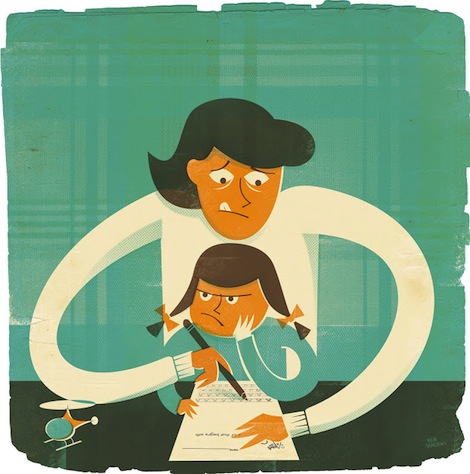Padres sobreprotectores ¿Es su estilo de crianza?
Los padres sobreprotectores generalmente quieren proteger a sus hijos del daño, del dolor y de la infelicidad, de las malas experiencias y del rechazo, de los sentimientos heridos, del fracaso y de las decepciones. Cuando los escuchas así, suena admirable, a primera vista, pero mira más de cerca y piensa en qué experiencias se les impide tener.
Los padres sobreprotectores a menudo impiden que sus hijos intenten o prueben nuevas actividades, tales como descubrir la emocion de escalar y del riesgo en los parques de aventuras. Les quitan las ganas a la hora de hacer actividades deportivas, o sociales que incluyen oportunidades para ganar destrezas sociales (intrapersonales e interpersonales).
Lo que muchos padres sobreprotectores no ven es que sus propios temores desde la infancia se están viviendo ahora a través de sus hijos, creando así una nueva generación llena de sus propios miedos y frustraciones.
Padres Sobreprotectores - Creando miedo
Es difícil para los padres sobreprotectores admitir la realidad de sus temores por sus hijos.
Estos temores se sienten muy reales y se hacen evidentes a través de declaraciones que a menudo incluyen tener cuidado y/o tener cuidado.
"Cuidado, te vas a caer!" cuando estés en un parque o patio de recreo, o "Ten cuidado, tendrás un accidente!" mientras montas en bicicleta.
Los padres sobreprotectores imaginan el miedo en la mayoría de las situaciones y poniendo este miedo en sus hijos/as, están creando miedo, ansiedad, haciendo que sus hijos e hijas sean emocionalmente inmaduros. El motivo principal es que les crean situaciones continuas de las cuales sus hijos luchan por escapar, hasta que finalmente no hay escape ya que los temores se han convertido en parte de la respuesta modelada para la manera de pensar de su hijo. No se les ensena una manera de experimentar por si mismos, sino que se les adelanta una respuesta negativa a sus experiencias.
Este tipo de crianza, basada en la asfixia, es ineficaz y no infunde virtudes y valores como responsabilidad, coraje, autoestima, autoestima, confianza en su hijo/a.
La crianza sobreprotectora da a los niños el mensaje de que no se les puede confiar
y que son incapaces de vivir situaciones normales que otros niños manejan con facilidad.
Padres helicóptero
En los últimos años, se ha acuñado un nuevo nombre para describir a los padres que son vistos continuamente sobreprotectores de sus hijos, particularmente en lo que respecta a su escolaridad. Se llaman así porque flotan cerca de sus hijos, rara vez dejándolos fuera de su alcance. Para crecer, conocer a los niños, la vergüenza causada por este comportamiento de los helicópteros de sus padres puede ser insoportable.
Si usted se reconoce a sí mismo como un padre/madre lleno de miedo, sobreprotector, que se cierne como un helicóptero sobre sus hijos/as, trate de obtener ayuda profesional para identificar por sí mismo donde se basan sus patrones.
Es posible que no pueda cambiar su pasado, pero ciertamente puede hacer cambios para su futuro y para sus hijos.
Padres Sobreprotectores - Responsabilidad (NO)hecha!
Este es uno de los ejemplos que podemos encontrar si usamos google:
"Mi hija más joven montó sobre cinco millas cada manera en su bicicleta a la escuela como un niño de nueve años. Ella eligió montar con un grupo de niños mayores, y disfrutó de la experiencia. Un grupo de madres, que llevaban a sus hijos a la escuela, un día, me preguntaron si creía que era prudente montar, dado que cruzaba caminos muy concurridos. Me sentí socavado y comencé a preguntarme, en mi interior, si era, de hecho, una decisión acertada, aunque habíamos hecho muchos viajes juntos por este mismo camino y teníamos un montón de discusiones sobre el uso de la bicicleta. Obviamente, esto se tradujo en miedo y ansiedad, y fue experimentado como tal por mi hija, porque me detuvo en mis pasos al declarar, "Mamá, siempre me ha gustado ir a la escuela en mi bicicleta, pero ahora ya no me siento seguro porque has empezado a preocuparte por ello". ¡Fuera chismes y habladurias! dejé ir mis miedos y le devolví un sentido de confianza y responsabilidad. Ella siguió viajando a la escuela por muchos años sin accidentes."
Padres Sobreprotectores - Viaje a la Independencia
Desde el momento en que nacen, los niños comienzan el largo camino hacia la independencia. Así que es lógico que los padres comiencen el largo viaje de dejar ir!
Anime a sus hijos/as:
Alentarlos a explorar, conquistar, escalar y dominar nuevas actividades proporciona los medios para un crecimiento y un aprendizaje enormes tanto para ellos como para nosotros como padres.
Para convertirse en adultos responsables, seguros, asertivos e independientes, los niños necesitan oportunidades para explorar su ambiente tanto física como emocionalmente, sin la interferencia continua de sus padres.
A menudo nos sentimos temerosos de ver a nuestros niños jugando en equipo de juego de tierra, escalada, o aprender a nadar o patinar, pero esto no tiene que traducirse en miedo por ellos.
Déjalo ir......
Deje ir y permita que sus hijos caigan, cometan errores, experimenten rechazo, sientan celos y sufren la derrota.
Dejar ir y ver cómo crecen en la confianza, la habilidad, la responsabilidad y la inteligencia emocional como aprenden de toda la vida tiene que ofrecer.
Deja ir tu apego a ser un padre sobreprotector y encontrar maneras constructivas de liberarte de tus miedos antes de dárselos a tus hijos. Obtenga ayuda profesional si su temor es agudo.
Otras lecturas en ingles sobre este tema:
- https://hemabhattgrowingkids.wordpress.com/tag/overprotective-parents/
- https://www.wikihow.com/Get-Freedom-with-Overprotective-Parents-as-a-Teenage-Girl


